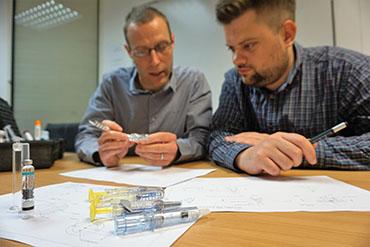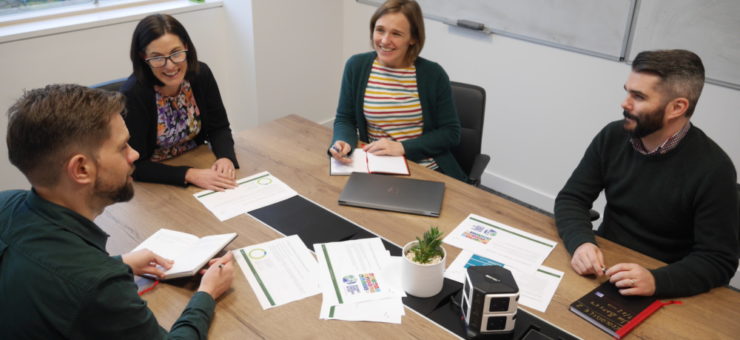How to find the best contract R&D partners
10 May 2023
“Most of us understand that innovation is enormously important. It’s the only insurance against irrelevance”
Gary Hamel
“Innovation requires the ability to collaborate and share ideas”
Bill Gates
Innovation is critical to all businesses. We live in a knowledge-driven economy and, especially in medical devices and drug delivery, giving patients the benefits of new and better products is clearly beneficial for all concerned: patients, payers, healthcare authorities, pharmaceutical companies, and medical device manufacturers.
Collaboration is more important than ever to manage technical risks and build on the best talent available throughout the development process. But there are very few sources of good information on how to find the best companies to collaborate with. This article gives an insight based on many years of experience in the field.
We hope that it is helpful and perhaps even interesting!

Step 1: Consider the pros and cons of working with external experts
Collaborating with external experts works best when you and the relevant stakeholders within your organisation (particularly the development team) see the value.
In some cases, there’s reluctance to collaborate, but it can lead to projects not working very well due to the limits of the skills, capability and equipment of your own development team.
In other cases, where you just want more people in your office or labs to work under your own supervision, a lone contractor may be more appropriate than an external R&D partner. Using contractors is a different mind set from working with external R&D companies because typically the latter will take on leadership to overcome hurdles in the way, and display a greater degree of autonomy on reaching a solution.
It is misleading to compare quotes to salaries. This is a common temptation, but when you consider the salary of yourself or your staff, you are not including pension, bonus, National Insurance, premises, training, recruitment costs, computers, software licences, under-utilisation, lab equipment, lab space, insurance, accounting and legal support and so on. If you add up those things for your internal team, you will find the market rate for R&D work. The quotes from potential partners should match this: they should be the market rate after all. When coupled with rapid and reliable progress on solving a valuable problem, the cost-effectiveness should be clear.
If you and your team do see the value in an external collaboration, move to Step 2…
Step 2: Think about what you’re asking for
What is it that you need? This will inform what you’re looking for in an external partner.
When it comes to specifying the size and shape of a project, there are 3 competing factors:
- Quality.
- Time.
- Cost.
Typically, you can optimise a project for any 2 of the above.
Step 3: Find out from peers who is good
Reputation is everything. A really good innovation partner will have a good reputation which others in your field will know about. If you don’t know who to ask, maybe former colleagues at another company can help. You can always get in touch and ask us!
You may already know that a company’s name being well-known correlates strongly with its marketing budget, and not necessarily with the quality of its work.
It is about the people, not the brands. We have found that the most important ingredient in successful development projects is the quality of the people. Two qualities stand out as being vital:
- Their technical and project management ability; and (no less)
- Their ability to communicate and work with you (and you trust them).
Really good engineers and scientists will be able to use the right technique and equipment even if they have not used exactly the same things before. On the other hand, it could be folly to expect mediocre engineers and scientists to develop market-leading high performance, usable and safe products, or fix non-trivial technical problems. Perhaps ask yourself this provocative question: “How many opportunities do I have to get this project right?”
There is sometimes a downside to really capable people: they can be arrogant and therefore not so good to work with. The best way to assess this is Step 4…
Step 4: Talk with the potential partners
It is worth spending the time to speak with potential partners because a website or word-of-mouth cannot give the full picture about the quality and attitude of the people actually working at the potential partner company. By definition, case studies on websites will be very old because they have to be outside of confidentiality terms. Therefore, the people that developed those devices might not be working at that company anyway.
Talking with the company can help you assess:
- Would I want to work with these people? Are they listening to me?
- Are they capable people who I trust to deliver the project successfully?
- Do they understand the constraints of the project?
Here is a list of common pitfalls to watch for:
- Be aware of the A-team/B-team. You might be talking to some experienced, capable people during the negotiation and planning, only to find that you get a completely different set of people working on the project once it starts. You can minimise this risk by seeking assurances about who would be working on the project: the partner should be able to at least be sure of the project leader.
- Ensure the correct incentives. If the potential partner has internal projects, it will be wanting to secure its own IP. If it has experience in your field, it is probably going to want to secure its own IP in your field. Development contracts can say that IP will belong to you, but perhaps you do not want an incentive for people working on your project to keep the best ideas for their company. The best way around this is to use a partner which does not have internal projects at all.
- Location is almost irrelevant. If you work for a leading multinational organisation, you probably want to find the best team in the world to deliver your projects – why not? The probability of having an excellent team available down the road is slim. If you do, that’s great! If you do not, it does not tend to matter these days whether they are 500 miles away or 1,500. Weekly web conferences cover most project updates, and regular face-to-face meetings are easy in this age of cheap and convenient air travel.
- Size is important, but maybe not how you think. A partner who is too small (one or two people) might not have the breadth and depth of the skills that you need, and you would be at the mercy of any one person being sick or taking holiday when you need them most. A large partner will prioritise their largest projects. If your project is many millions of dollars in each phase, great! if not, you might find you are not at the front of the queue for resources if you use large partners.
- Will the rest of your company treat your partner well? You may have found the right partner who you trust and you’re really keen go get a great project going. It helps the relationship, and therefore chances of success, if your procurement department agrees to reasonable payment terms, and your accounts department fulfils its obligation to pay on time.
Step 5: Decide who you want to work with
This may be the hardest step. There are any number of approaches to come to a decision…
Factors such as trust in the people, and your belief in their ability to deliver are hugely important. Therefore, a spreadsheet of metrics (beloved by procurement departments) is probably not the best way to decide between potential partners.
Perhaps the best way is to think about which partner you would prefer to have a long-term business relationship with, and see if their match to the current project need is good enough.
If this post has teased any thoughts or questions, please either write a comment below, or get in touch. We would love to hear from you.
Article originally published in 2017 and updated on 10/05/2023.


